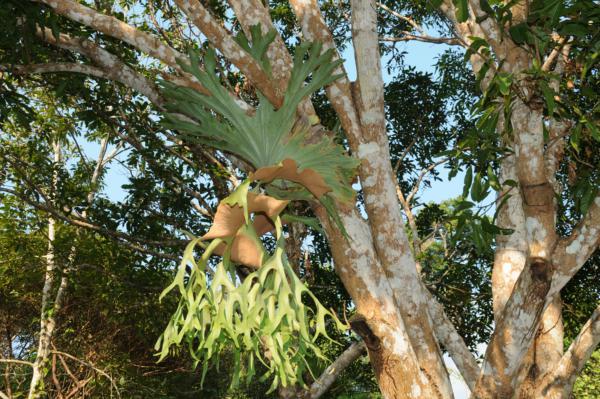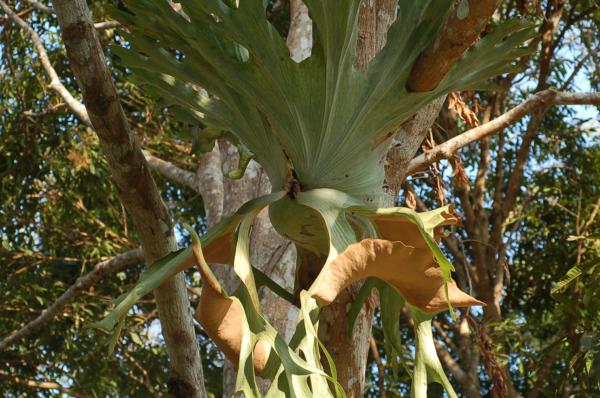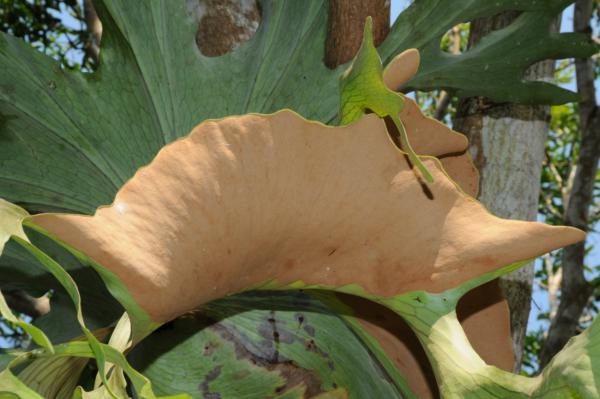
Platycerium holttumii de Jonch. & Hennipman
Family
Polypodiaceae
Nomenclature
Platycerium holttumii de Jonch. & Hennipman, Brit. Fern Gaz. 10: 116, pl. 12, f.1–3. 1970; Hennipman & Roos, Verh. Kon. Ned. Akad. 80: 101, f. 25 & 26, pl. 2. 1982; Tagawa & K.Iwats., Fl. Thailand 3: 489. 1989; Hennipman & Roos, Fl. Males., Ser. II, Ferns and Fern Allies 3: 139. 1998; Boonkerd & Pollawatn, Pterid. Thailand: 257, 283. 2000; Newman et al., Checkl. Vasc. Pl. Lao PDR: 30. 2007. – Type: Hennipmann 3968 (L; iso BKF, KYO), Thailand.
Platycerium grande auct. non J.Sm. ex Hook.: Bedd., Handb. Ferns Brit. India: 445, f. 271. 1883, p.p.; C.Chr., Contr. U.S. Natl. Herb. 26: 335. 1931; Tardieu & C.Chr., Fl. Indo-Chine 7(2): 446, f. 52.1. 1941; Newman et al., Checkl. Vasc. Pl. Lao PDR: 30. 2007.
Description
Rhizome scales basifixed, 15–28 by 1.5–4.5 mm, index 5–9, widest near the base, margin with hairs up to 1 mm long, apex acute to acuminate, midrib absent. Fronds strongly dimorphic with nest leaves and fertile fronds. Nest leaves base sessile, green, recurving when old, 90–115 by 90–135 cm, lower part with sinuous margin, upper part spreading, 3–6 x forked equally, basal fringe conspicuous. Foliage fronds maturing in symmetrical pairs, asymmetrical, 95–125 cm long, with 2 unequally long main lobes, each with a wide, horizontal soral patch and 2 lateral, pendulous lobes, those of the central main lobe forked 3–5 times, of the lateral main lobe forked 2–3 times. Hairs with 9–13 rays up to 0.3 mm long. Soral patch semicircular, 10–45 by 8–35 cm; sporangia with (16–)18–21 indurated annulus cells. Spores 64 per sporangium .
Distribution in Thailand
NORTHERN: Chiang Mai, Tak; NORTH-EASTERN: Loei, Nong Khai; EASTERN: Chaiyaphum, Nakhon Ratchasima; SOUTH-WESTERN: Kanchanaburi; SOUTH-EASTERN: Chanthaburi.
Distribution in Laos
Luang Phrabang, Xieng Khouang.
Distribution in Cambodia
Unspecified.
Wider Distribution
Indochina and Peninsular Malaysia.
Ecology
On tree trunks in monsoon forests at low aititudes, rather rare.
Proposed IUCN Conservation Assessment
Least Concern (LC). This species is widespread and not under any known threat.
Habit
Nest leaves and fertile lobes
Fertile lobes
Site hosted by the Royal Botanic Garden Edinburgh. Content managed by Stuart Lindsay, Gardens by the Bay, Singapore and David Middleton, Singapore Botanic Gardens. Last updated 24 January 2012


